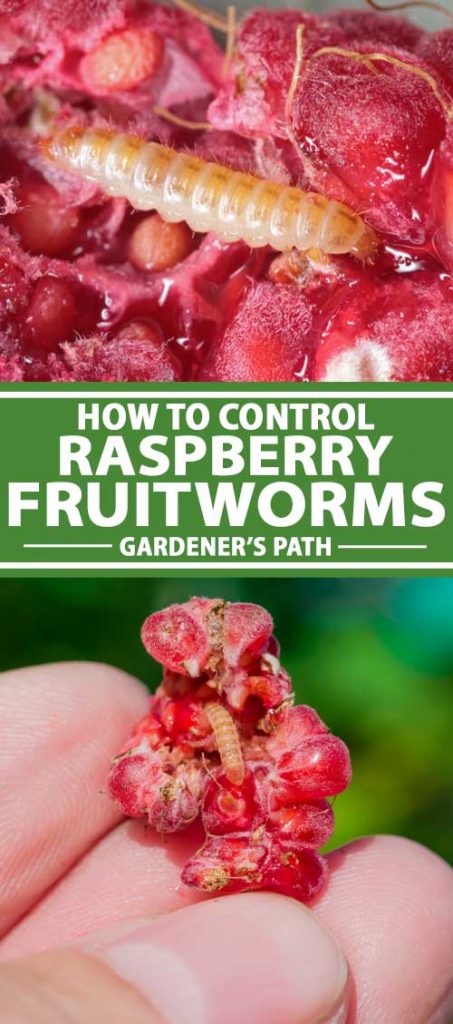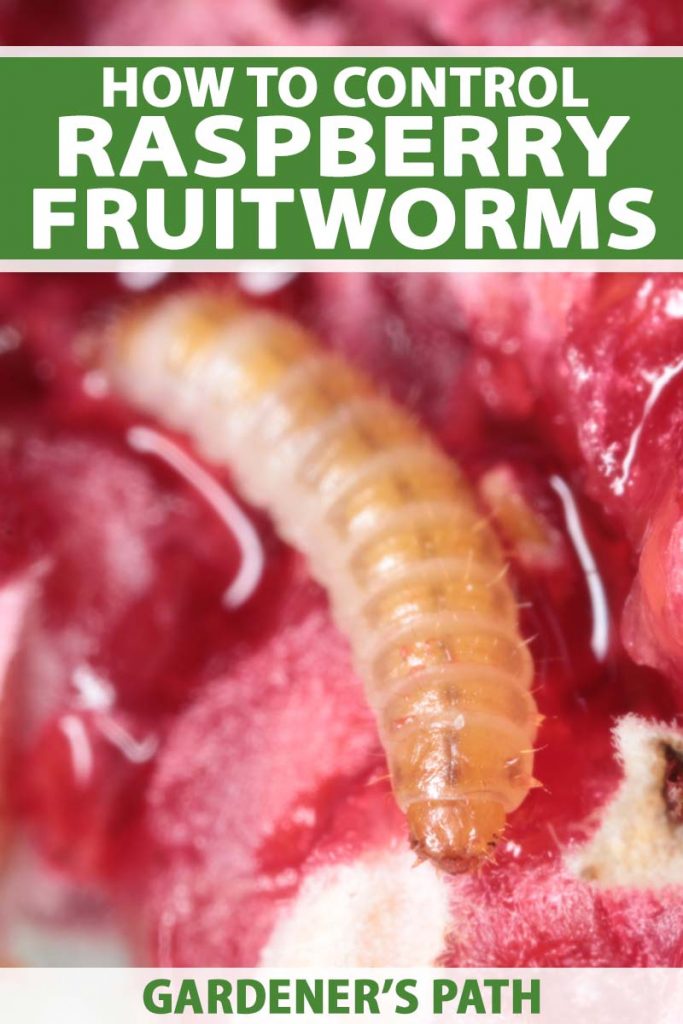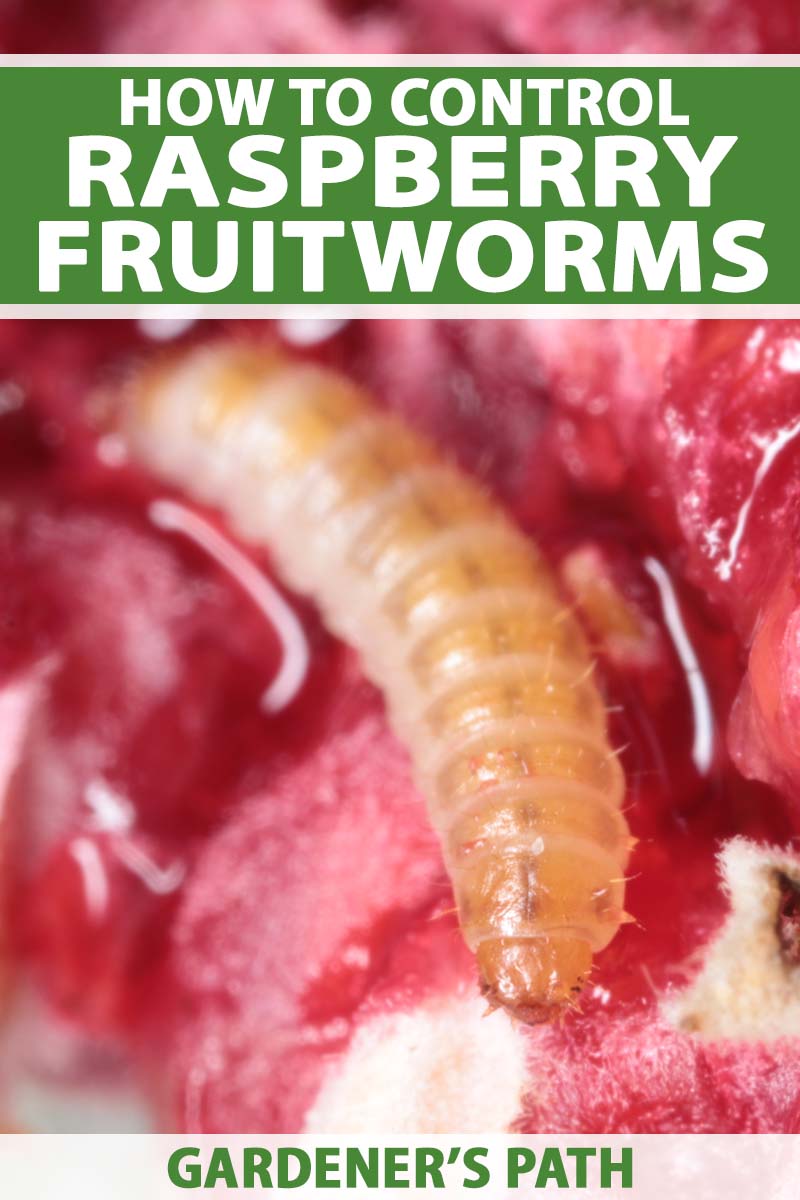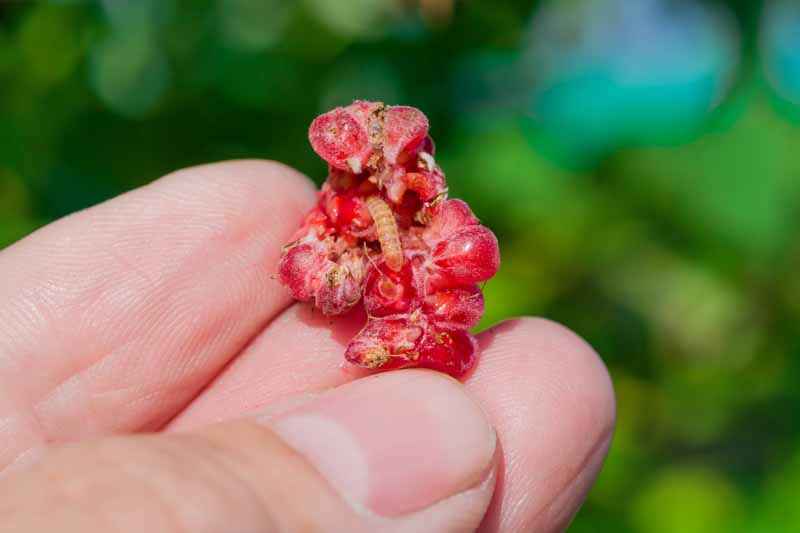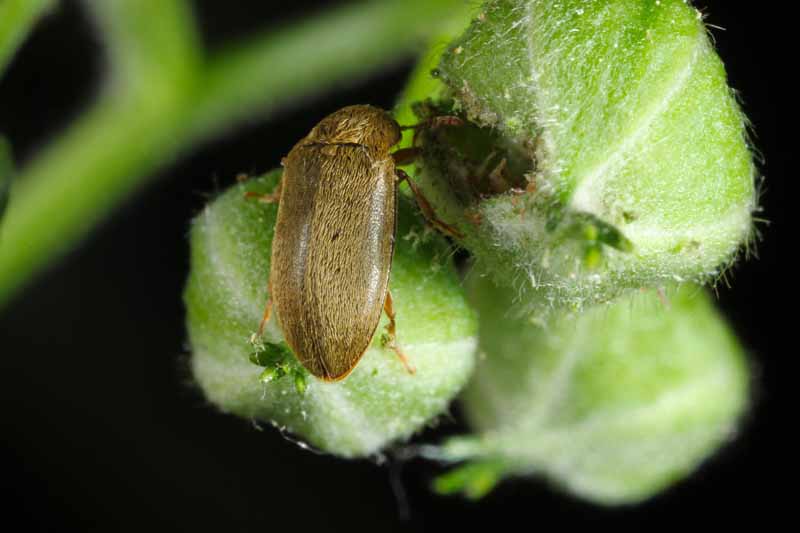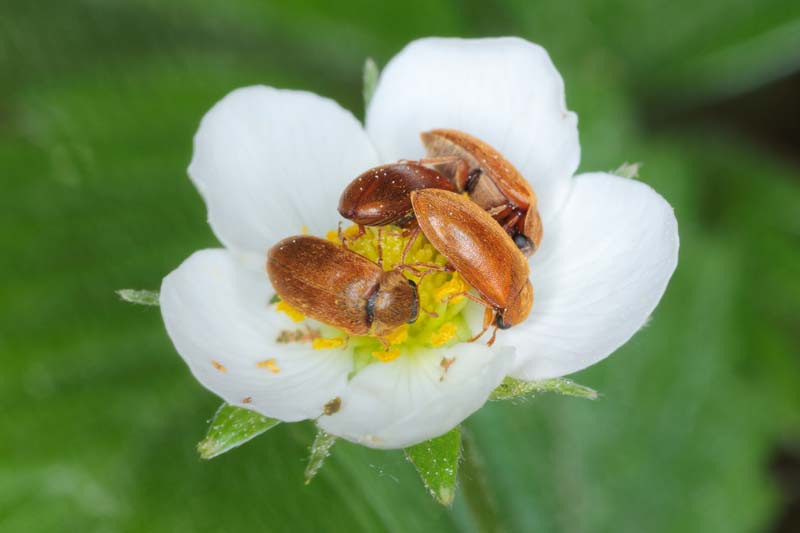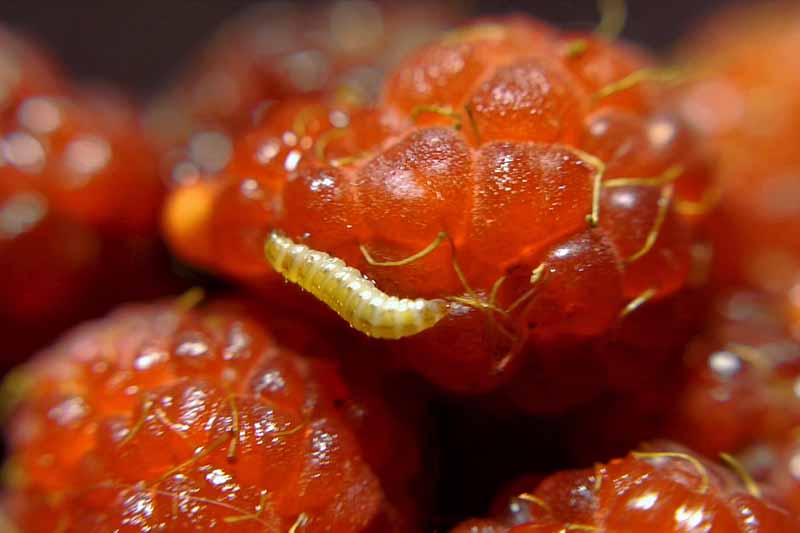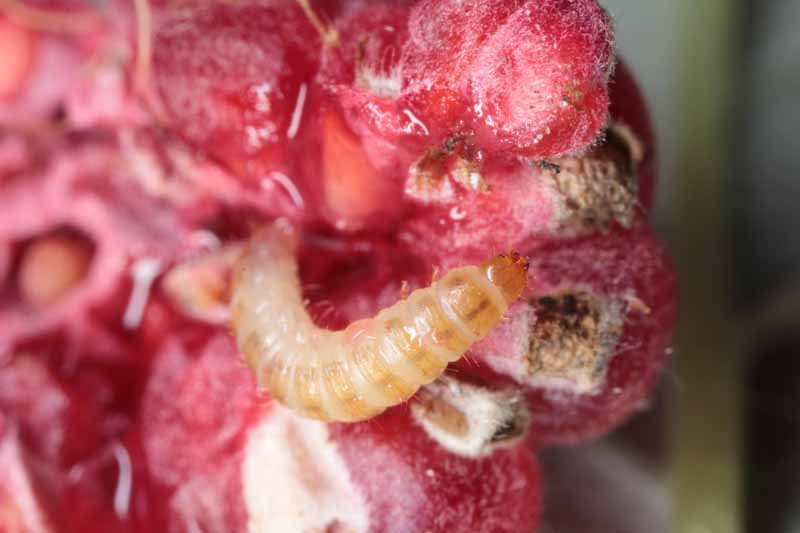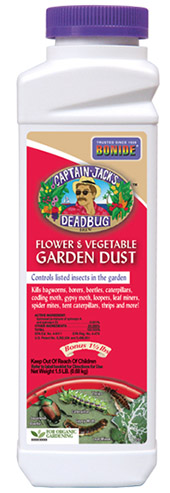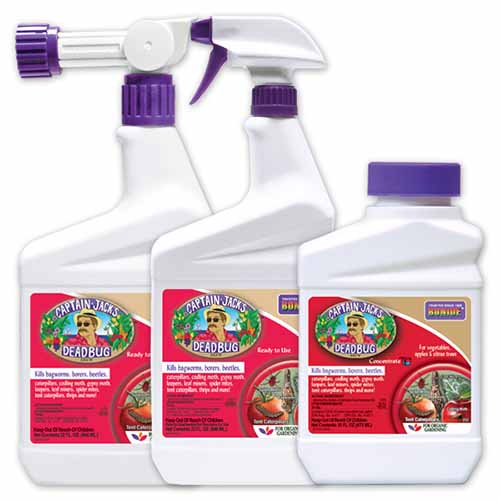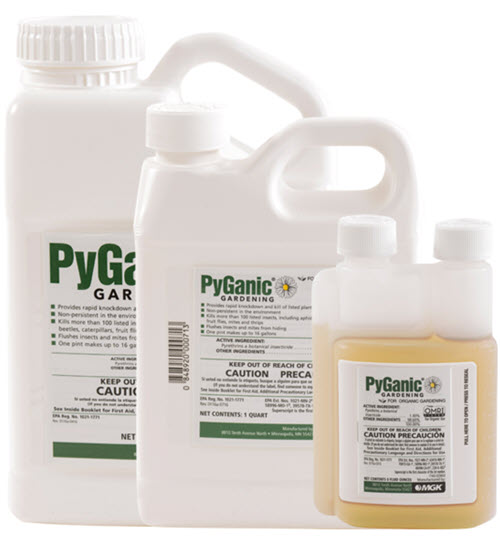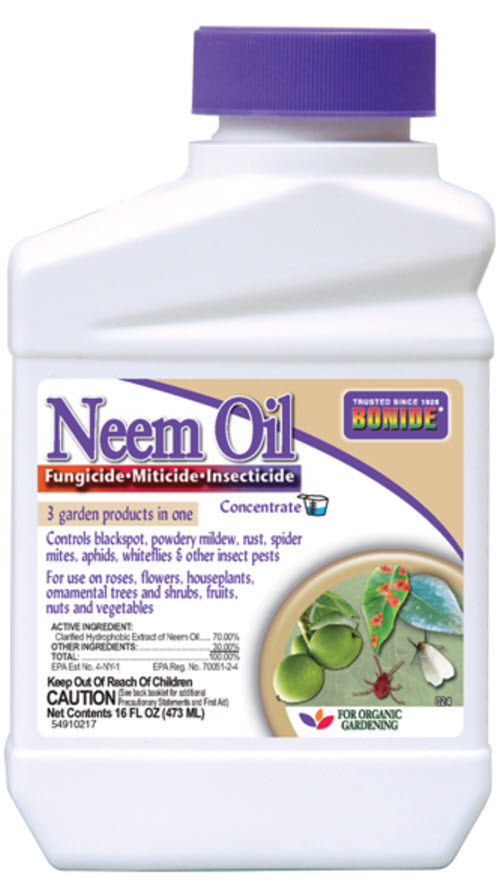The damage caused by these beetles can range from the occasional worm in a homegrown raspberry to major destruction of the leaves and severe infestation of the berries throughout your crop. In addition, heavy damage to the leaves can result in a weaker plant that will produce fewer fruits. Such tiny beetles can cause so much damage! We link to vendors to help you find relevant products. If you buy from one of our links, we may earn a commission.
Identification, Biology, and Distribution
There is some confusion about the name of these pesky worms that can ruin your delightful raspberries. While many people still call them raspberry worms, some experts call them “raspberry beetles” and consider “Western raspberry fruitworm” to be an outdated name.
In the US, the scientific name of the fruitworms has changed over time. Originally, there was Butyrus rubi on the East Coast and B. bakeri on the West Coast. However, both species as they were originally classified have now been merged into one – B. unicolor. Its range extends from California and Arizona up through Canada to the Arctic. Europe and Asia have their own species – B. tomentosus. It is particularly prevalent in the United Kingdom, and frequently causes major damage to raspberries, blackberries, and hybrid berries such as boysenberries, loganberries, and tayberries. The North American species also infests a range of brambles, including many wild species. Thimbleberry (Rubrus parviflorus) appears to be the favorite host among the wild Rubus species – probably because it flowers at the same time as most cultivated red raspberries. Summer crops suffer the most severe damage, since production coincides with the life cycle of these insects. Fall crops, on the other hand, tend to escape unscathed. The brown to reddish-brown adult beetles are oval-shaped, somewhat hairy, and tiny – about 4 millimeters long.
The larvae are whitish yellow and range in size from 6 to 8 millimeters long. They look like grubs and their bodies are segmented.
Life Cycle
The adults overwinter in the soil, so they are poised to strike when plants start producing leaves in the spring. When they emerge from the ground, the beetles start flying and continue to do so until August. B. tomentosum flies to alternate hosts, including pear, hawthorn, and apple, returning to the raspberry plants once the flowers start blooming. In contrast, once B. unicolor beetles start flying, they begin feasting on the midribs of partially folded leaves. They are the most active in the evening. When the flower buds start to form, the beetles chew into them and then move inside the buds once they separate. They leave a large telltale entrance hole behind. The beetles either lay their eggs on buds that have not opened, or lay them inside the flowers and developing fruit. Each female beetle can lay 100 or more eggs. When the larvae hatch, they typically feed on the flowers before making their way into the center of the developing fruit. This often damages the fruit or causes it to drop prematurely.
The larval stage continues for about a month, until the insects drop to the ground in midsummer. Then, they pupate, and the adults spend the winter in the soil. Fall crops typically aren’t damaged by fruitworms because the insects are already buried in the soil at this time.
Raspberry Symptoms
The initial signs that your raspberries are infested by these beetles are elliptical holes in the foliage. If there are a lot of beetles, you will see slits where the adults ate around the veins of the leaves. If the infestation is heavy, the adults can severely damage the canes. Blossoms injured by these pests often develop into distorted berries.
The need for control will vary depending on how you want to use the berries. For example, the presence of these pests is less critical if the fruit will be made into juice or puree. However, if you were planning to sell your harvest, the presence of fruitworms can significantly impact your bottom line. This is particularly true for fruits that will be “individually quick frozen.” That’s why it is so important to monitor the level of infestation to determine whether or not you need to take measures to control them.
How to Monitor for Raspberry Fruit Worms
The pre-bloom phase in the spring is the critical time to start checking for the presence of raspberry beetles. The most effective way to limit an infestation is to kill the adults before they lay eggs that will hatch out as larvae. Once the larvae have infested the fruit, you will not be able to kill them with insecticides. You will have to manually remove the infested berries and destroy them. Washington State University’s Whatcom County Extension provides a detailed document on integrated pest management (IPM) for raspberry fruitworms and describes the monitoring processes in detail. I’ll provide an overview here.
Scouting
To start, you can look for the insects and signs of damage the old fashioned way. For example, if you note a lot of damage to the leaves, that could indicate the presence of large populations of adult beetles.
White Sticky Traps
If you want to get more precise, you can attract the adults with white sticky traps made from cardboard that doesn’t reflect UV light. One recommended brand is Rebell® Bianco. Why do these traps work so well? Believe it or not, the fruitworms think they are raspberry flowers. A good place to set them up is around the edges of your bramble patch, particularly if you have any wild berries growing there. There is a good chance that the wild berries will attract larger numbers of adult beetles, so your odds of catching them are greater in those locations. Place the trap on the top wire and keep a map of where you put them in your gardening journal. You should check your traps weekly. This will help you to select a course of action for treatments, or to determine whether treatment is unnecessary, based on your tolerance level (which we will discuss in the next section). Note the date, the number of beetles that have been caught, and the location of the traps.
Beating Trays
You can use beating trays to dislodge insects from the canopy. The idea is that they will fall into your tray, and you can count them. You should hold the tray one foot below the trellis wire in the canopy. You have two choices to dislodge the insects:
Grab the wire and shake the foliage Take a rubber sprayer hose and hit the top wire three times
Note how many beetles you have caught.
Choosing a Tolerance Level
Now you have to decide what number of adult raspberry worms in your crop justifies taking action. The need for action will depend a great deal on the final destination of your fruit. Raspberries used for juice can contain more larvae than ones that are destined for immediate fresh consumption, at least in a commercial setting. You can get away with letting more beetles slide if you will be hand harvesting your fruit as well, rather than using a machine harvester. The home grower can sort and discard any damaged fruit. The highest standards of control are required if your fruit are destined for immediate quick freezing, for commercial sale. Whatever your circumstances, you have the choice of not treating, treating part of your crop, or treating your whole field. If you only have a couple of bushes growing, you will probably want to take whatever action you can to ensure a good harvest. It is not uncommon to have patchy results, with some parts of the field having greater numbers of adult beetles present than others. Growers in this situation have had some success just treating the areas where they found more beetles. The good news is that the presence of just a few beetles does not necessarily mean that your fruit are contaminated with larvae. But you should consider treating your plants if you find adult beetles at most of the sites you check. So where does tolerance come in, in terms of actual numbers to keep in mind? One recommended rule of thumb is to consider treatment if you find more than five adult beetles in your beating tray samples. Think toward the future, too. If you find a lot of beetles, that is probably a good indication that you will need to treat your raspberry plants next year as well.
How to Control Raspberry Fruitworms
You have a choice of control options, depending on how severe the infestation is on your raspberry plants. Unfortunately, beneficial insects have not been found to be effective in controlling raspberry fruitworms – mostly because the larvae hide inside the fruit and are inaccessible to them.
Till the Ground
It may sound old school, but hoeing or tilling in the late spring and early summer can be surprisingly effective. It rousts the adults and pupae out of the soil and onto the surface, where the birds can eat them. This is a nice change of pace considering that crows, starlings, and blackbirds alone cause more than $150 million in damage to fruit, berry, and grain crops in the US each year. Imagine happily welcoming them to your garden, and providing a tasty meal that will result in a delicious harvest for you to enjoy later in the season! (Don’t hesitate to apply some bird netting when berry production time rolls around, so you can keep the majority of the delicious harvest for yourself).
Clean Up Weeds
Maintaining good weed control can be surprisingly helpful. The adult beetles spend a significant amount of time eating the pollen of flowering weeds – especially composite flowers like dandelions. This can have a noticeable effect on your raspberry plants, since the damage from raspberry fruitworms tends to be more severe in weedy areas.
Host Plant Odor Traps
The Royal Horticultural Society of the UK recommends using a volatile compound that mimics the odor of the host plant (aka a karimone) to lure the flying beetles. The smell will draw both male and female raspberry beetles into a water trap – an effective way of eliminating them. Set the traps out 4-6 weeks before the first flowers appear on your plants. One of the advantages of this type of trap is that it attracts the beetles as they exit the soil, before they attack your raspberry plants. However, if you find that you are trapping more than 5-10 beetles per week before the flowers appear, a significant number, you should also consider using an insecticide.
Organic Insecticides
If you prefer to use an organic insecticide, you have several options. These can be sprayed when the flower buds are first visible, and again before the flowers open. This will limit the populations of adult beetles, and therefore reduce the amount of larvae that will end up in your fruit. You should avoid spraying when your plants are blooming, so you won’t kill bees or other pollinating insects. This is true for both organic sprays and synthetic insecticides. The use of synthetic chemical pesticides is another control option that is available to you. If your growing operation is certified organic, keep in mind that there are some differences between the available products. Be sure to read the labels and make your selection carefully before you spray. The product available from Entrust is OMRI-labeled, so it is certified organic, whereas the spinosad product known as Success is not.
Bonide Spinosad Powder For home gardeners, I suggest using Captain Jack’s Deadbug Flower & Vegetable Garden Dust from Bonide. Spinosad is the active ingredient in this product, and you can pick some up from Arbico Organics.
BONIDE® Captain Jack’s Deadbug Brew™ Spinosad is also available in liquid form from Arbico Organics, in pre-mixed spray bottles of various sizes from Bonide.
Pyrethrins
Use of pyrethrins can also be effective against these insect pests. These chrysanthemum-based compounds don’t persist for long on plants after spraying, so you will need to apply them more frequently than conventional chemical insecticides.
PyGanic Gardening EC 1.4 II Pyrethrin Liquid Spray Brands that are labeled for controlling raspberry fruitworms include PyGanic EC 1.4 II and EC 5.0 II. You can pick up a bottle of PyGanic via Arbico Organics. Be sure to wait at least one day after spraying to harvest your fruit, and follow the manufacturer’s directions for application.
Neem Derivatives
Neem seeds contain the insecticidal compound azadirachtin, which has been incorporated into a number of formulations that state they are effective against raspberry fruitforms. These include Aza-Direct, AzaGuard, AzaMax, AzaSol, Azatrol-EC, Ecozin Plus 1.2% ME, and Neemix 4.5. Arbico Organics carries many of these products.
Bonide Neem Oil For home gardeners, Bonide® Neem Oil comes highly recommended. This product is often available locally at plant nurseries and hardware stores, or you can order it from Arbico Organics.
Synthetic Insecticides
You can apply synthetic insecticides to prevent infestation of your plants before flowering, or when about 5% of the flowers have opened. Spraying at each of these suggestions times should provide greater control against these pests, with better results. Classic insecticides that are effective against the raspberry beetles include methoxychlor, malathion, carbaryl, and diazinon. You also have the option of using synthetic pyrethroids, including:
Cypermethrin Deltamethrin Lambda-cyhalothrin
You may achieve better results using these synthetic pyrethroids than you would if you chose the more natural compounds. But there are potential downsides as well, in terms of effect on the environment and other factors. Be sure to always read labels thoroughly and use chemical pesticides only as directed.
Tiny Beetles Can Cause Significant Damage to Raspberries
Beetles in the Butyrus genus are tiny insects that can cause significant damage to summer raspberry crops.
These pests, also known as raspberry fruitworms, infest the fruit and greet unwary consumers with an unpleasant surprise. You have some leeway in the amount of fruitworms that are considered acceptable in your crop, depending on whether they will be enjoyed by the home gardener or sold, and eaten fresh out of hand or made into juice. Have you dealt with raspberry fruitworms in your plants? If so, let us know how it went in the comments. © Ask the Experts, LLC. ALL RIGHTS RESERVED. See our TOS for more details. Product photos via Bonide and PyGanic. Uncredited photos: Shutterstock.
